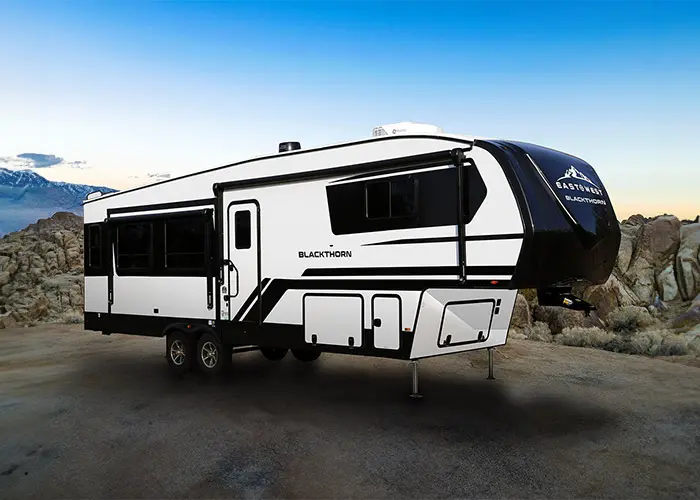What Is a Fifth Wheel?
Introduction, Basics, and the Evolution of a Towable Icon
If you’ve been researching RVs and campers, chances are you’ve stumbled across the term “fifth wheel.” But what does it actually mean? Is it a type of trailer? A kind of hitch? Or something else entirely?
In the world of towable RVs, fifth wheels stand out for their unique design, enhanced towing stability, and spacious, residential-style interiors. Whether you're brand new to RVing or considering an upgrade, this guide will walk you through what a fifth wheel is, what makes it different, and how the concept has evolved from its industrial roots into a beloved choice for road warriors and full-timers alike.
What Is a Fifth Wheel?
A fifth wheel is a type of RV that’s towed using a special hitch installed in the bed of a pickup truck. This hitch—called a fifth wheel hitch—connects to a pin box located under the front section of the trailer, allowing it to pivot smoothly and distribute weight more evenly than traditional bumper-pull trailers.
While the name might sound a bit mysterious, it actually comes from early 20th-century transportation technology (more on that in a bit). Today, fifth wheels are known for their comfort, livability, and towing performance.
Key Characteristics of Fifth Wheel RVs
Fifth wheels are packed with features that make them a favorite among RV enthusiasts. Here are the main things that make them stand out:
1. Raised Forward Section
One of the most recognizable traits of a fifth wheel is its elevated front portion, which typically sits over the bed of the truck. This area often houses the master bedroom or a cozy lounge area, creating a split-level design that maximizes interior space without increasing overall length.
2. Spacious and Luxurious Interiors
Thanks to their design and the extra square footage afforded by slide-outs, fifth wheels often feel more like luxury apartments on wheels than simple trailers. You’ll find:
- Full-sized kitchens with residential appliances
- Large bathrooms with stand-up showers
- Generous living rooms with theater seating and entertainment centers
- Separate bedrooms with king or queen beds
- Optional bunkhouses or lofts for families
This makes them especially appealing to full-time RVers, retirees, and families who want space to stretch out and relax on long journeys.
3. Improved Towing Experience
Because the hitch point sits directly over the truck’s rear axle (rather than behind it like a travel trailer), fifth wheels offer:
- Greater stability at high speeds
- Tighter turning radius
- Less sway, especially in windy conditions
- Better weight distribution, reducing wear on the tow vehicle
While you do need a pickup truck—usually a ¾ ton or heavier—to tow a fifth wheel, many RVers find the tradeoff in comfort and control well worth it.
4. Storage and Utility
Most fifth wheels come equipped with extensive basement storage (below the main floor), pass-through compartments, and the capacity for solar, washer/dryer setups, and even outdoor kitchens. This makes them perfect for extended trips or off-grid living.
A Quick Look at Fifth Wheel History
The fifth wheel coupling isn’t a new invention. Its history actually goes back over a century and is tied to the development of commercial transportation.
Early 1900s: Origins of the Fifth Wheel
The term “fifth wheel” originally referred to a horizontal wheel or plate used on horse-drawn carriages and early trucks to facilitate turning. It allowed the front axle to pivot independently of the wagon, making tight turns possible—especially important for heavy loads.
As technology advanced, this concept was adopted by the trucking industry. It became standard for connecting semi-trailers to tractors, allowing for heavy hauling and flexible movement on the road.
Mid-1900s: Recreational Adaptation
In the 1950s and 60s, as recreational vehicle travel gained popularity, RV makers began exploring new designs that would offer better towing stability and more living space. The idea of mounting a trailer over the bed of a truck—similar to commercial fifth wheel couplings—caught on.
By the 1970s, fifth wheels were entering the mainstream. They offered a more luxurious, longer-term camping experience than many of the smaller towables available at the time.
Today: Fifth Wheels Go Big and Smart
Modern fifth wheels have evolved far beyond their utilitarian roots. Today’s models often include:
- Smart home features (app-controlled lighting, climate, and security)
- Auto-leveling systems
- Heated tanks and four-season insulation
- Innovative layouts with rear kitchens, front living rooms, or even toy haulers
They’ve become a top pick for RVers who want the freedom of travel without sacrificing the comforts of home.
Is a Fifth Wheel Right for You?
Here are a few quick questions to help you decide:
- Do you own (or are you willing to buy) a pickup truck capable of towing a large RV?
- Are you planning to spend extended time in your RV—seasonally or full-time?
- Do you value space, privacy, and residential-style features?
- Would you benefit from improved towing stability compared to a travel trailer?
If you answered “yes” to most of these, a fifth wheel might be your perfect match.
Explore Fifth Wheels at KunesRV
At KunesRV, we offer a wide selection of new and pre-owned fifth wheels from trusted brands like Grand Design, Keystone, Forest River, and more. Whether you're a weekend camper or a full-time RVer, our experienced team is here to help you find the model that fits your lifestyle, your travel goals, and your budget.


